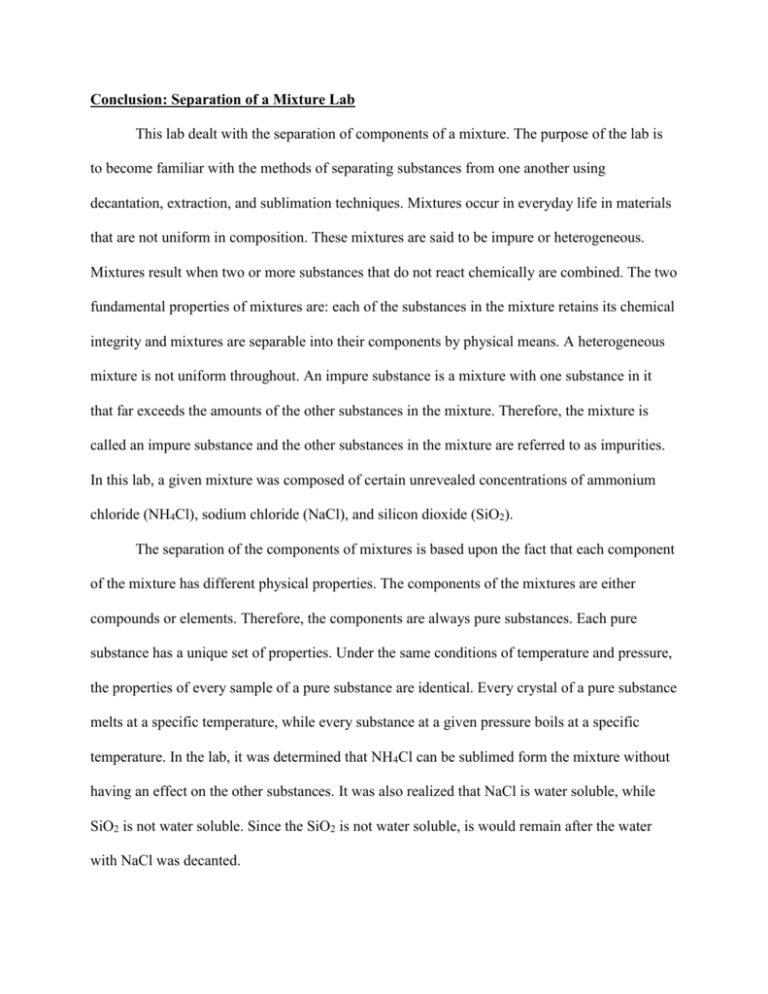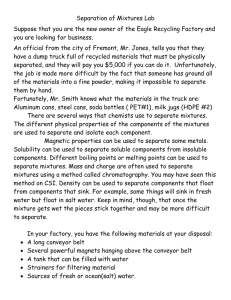Conclusion
advertisement

Conclusion: Separation of a Mixture Lab This lab dealt with the separation of components of a mixture. The purpose of the lab is to become familiar with the methods of separating substances from one another using decantation, extraction, and sublimation techniques. Mixtures occur in everyday life in materials that are not uniform in composition. These mixtures are said to be impure or heterogeneous. Mixtures result when two or more substances that do not react chemically are combined. The two fundamental properties of mixtures are: each of the substances in the mixture retains its chemical integrity and mixtures are separable into their components by physical means. A heterogeneous mixture is not uniform throughout. An impure substance is a mixture with one substance in it that far exceeds the amounts of the other substances in the mixture. Therefore, the mixture is called an impure substance and the other substances in the mixture are referred to as impurities. In this lab, a given mixture was composed of certain unrevealed concentrations of ammonium chloride (NH4Cl), sodium chloride (NaCl), and silicon dioxide (SiO2). The separation of the components of mixtures is based upon the fact that each component of the mixture has different physical properties. The components of the mixtures are either compounds or elements. Therefore, the components are always pure substances. Each pure substance has a unique set of properties. Under the same conditions of temperature and pressure, the properties of every sample of a pure substance are identical. Every crystal of a pure substance melts at a specific temperature, while every substance at a given pressure boils at a specific temperature. In the lab, it was determined that NH4Cl can be sublimed form the mixture without having an effect on the other substances. It was also realized that NaCl is water soluble, while SiO2 is not water soluble. Since the SiO2 is not water soluble, is would remain after the water with NaCl was decanted. This lab was concerned with the separation rather than the identification of the components of a mixture. The separation of the substances depended upon their physical properties. Filtration is the process of separating a solid from a liquid by means of a porous substance-a filter-which allows the liquid to pass through but not the solid. Sublimation is the process in which a solid passes directly to the gaseous state and back to the solid state without the appearance of the liquid state. Not all substances possess the ability to be sublimed. Since NH4Cl can easily be sublimed, it was sublimed from the mixture. The substance gave off white fumes. The mass of the small beaker with the original sample was 69.015g. After the NH4Cl was sublimed, the mass of the small beaker with the rest of the mixture in it was 68.911g. Therefore, the mass of the NH4Cl was 0.104g. Decantation is the process of separating a liquid from a solid by gently pouring the liquid from the solid as not to disturb the solid. Extraction is the separation of a substance from a mixture by preferentially dissolving that substance in a suitable solvent. Therefore, in this process a soluble substance can be separated from an insoluble substance. After subliming the NH4Cl water was added to the small beaker containing the rest of the mixture in order to dissolve the NaCl. The water with the dissolved NaCl was decanted from the small beaker leaving the insoluble SiO2 in the beaker. The water was then evaporated, and the mass of the watch glass and evaporating dish with the salt in it was recorded as 48.790g. Since the mass of the evaporating dish and watch glass was 48.140g, the mass of the NaCl was determined as 0.650g. After the sand dried, the mass of the small beaker and SiO2 was then recorded at 68.202g. Since the mass of the evaporating dish was 67.409g, then the mass of the SiO2 was 0.793g.








